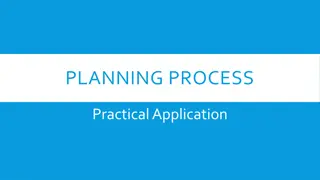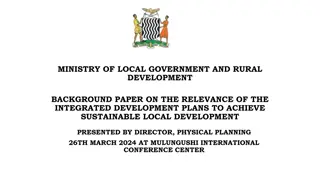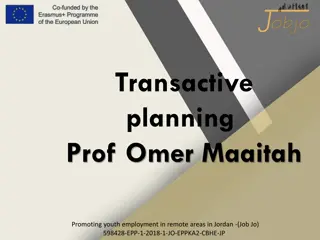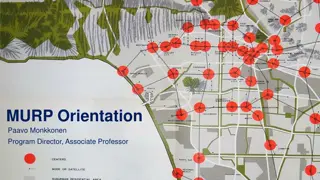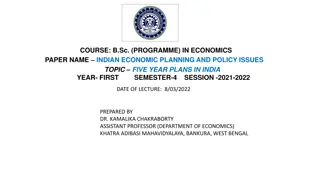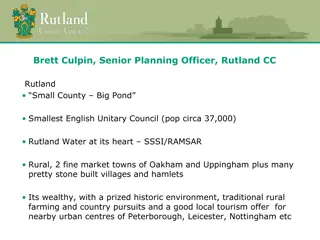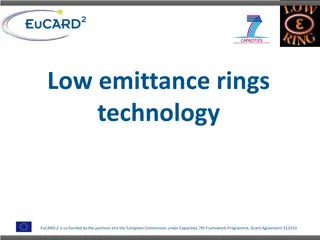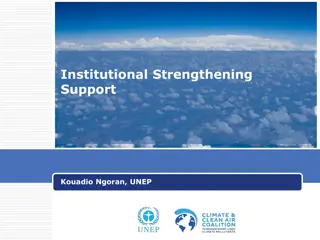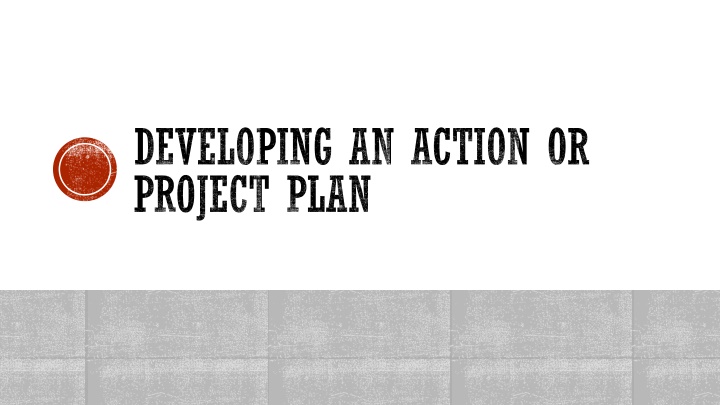
Developing Action Plans for Self-Governance and Partnerships
Discover a comprehensive guide on developing action plans for self-governance initiatives, including goal setting, resource allocation, internal team utilization, consultancy considerations, partnership development, and program assumption strategies.
Uploaded on | 0 Views
Download Presentation

Please find below an Image/Link to download the presentation.
The content on the website is provided AS IS for your information and personal use only. It may not be sold, licensed, or shared on other websites without obtaining consent from the author. If you encounter any issues during the download, it is possible that the publisher has removed the file from their server.
You are allowed to download the files provided on this website for personal or commercial use, subject to the condition that they are used lawfully. All files are the property of their respective owners.
The content on the website is provided AS IS for your information and personal use only. It may not be sold, licensed, or shared on other websites without obtaining consent from the author.
E N D
Presentation Transcript
DEVELOPING AN ACTION OR PROJECT PLAN
PLANNING FOR ACTION Set a goal Why Self-Governance? Identify action steps Prepare a timeline Allocate resources internal capacity and Tribal leadership Identify possible problems Develop strategies for monitoring progress Assign tasks Estimate costs Execute the plan
SELF-GOVERNANCE PLANNING Determine Eligibility Plan to Maintain Identify Resources Internal & External Set a Timeline Research Programs, Services, Functions, and Activities (PSFAs) Select PSFAs for Assumption Negotiate Compact and Funding Agreement Plan for Transition
INTERNAL TEAMS Use of Internal Teams Organized by subject matter/expertise Finance Human Resource Health Policy Others? Planning Negotiation Implementation
CONSULTANTS Should supplement internal/tribal capacity Tribally-driven process Goals-driven process Possible Areas for Consulting: Finance/Audit Finding Resolution Health Management & Policy Self-Governance
DEVELOPING PARTNERSHIPS Other Area Tribes, Self-Governance Tribes Other Tribal Programs Related and unrelated to Health Examples? Indian Health Service OTSG, Program Offices, Business Office, etc. Local and Regional Providers Higher Education Institutions
APPROACHES Specific Program Assumption: Collaboration with Tribal Programs Phase-in strategies: Very useful for Tribes new to SG; Roll over Title I Contracts into FA and add Tribal Shares and related PSFAs; Incrementally add feasible PSFAs over time; and Allows infrastructure growth along side Tribal assumption of health programs. Total Service Unit Assumption: Plan, plan, plan Anticipate execution Identify possible problems
IDENTIFYING PROGRAMS, SERVICES, FUNCTIONS, AND ACTIVITIES (PSFAs)
WHAT ARE PSFAS? Programs, Services, Functions and Activities; Programs (high level), Activities (detailed level); Describe all contractible operations of the IHS, both administrative and programmatic, at each organizational level;
RESEARCHING PSFAs Detailed information is needed on all PSFAs considered for assumption by the Tribe; For new SG Tribes, it is advised that information be obtained on all PSFAs; Research will allow the Tribe to make informed decisions about PSFAs to assume, conduct internal management planning, as well as to provide awareness of remaining responsibilities of the IHS.
PSFAs INFORMATION SOURCES Agency Lead Negotiator (ALN); Office of Tribal Self-Governance; HQ, Area and Service Unit staff; Self-Governance Education & Communication; Other Self-Governance Tribes.
STEPS Request/Obtain financial and PSFA information from the ALN, including all PSFA manuals applicable to your Tribe; Review in conjunction with the financial information provided; Request meetings with HQ, Area or SU staff as needed to answer questions and provide in-depth information about IHS operations; Utilize SG Tribal networks.
ANALYSIS AND DECISION MAKING Community and Tribal Leader direction this should guide overall PSFA analysis and priority-setting. This will ensure that the resulting course of action will contain strategies to make health services more responsive to the articulated needs and desires of the Tribal community and its Leaders. The Congress hereby recognizes the obligation of the United States to respond to the strong expression of the Indian people for self-determination by assuring maximum Indian participation in the direction of educational as well as other Federal services to Indian communities as to render such services more responsive to the needs and desires of those communities. (25 U.S.C. 450a(a))
ANALYSIS AND DECISION MAKING Determining feasibility of assuming specific PSFAs, or portions thereof: Population to be served; Financial considerations; Opportunities and challenges; Internal management preparedness; Improvement of healthcare outcomes; Phase-in strategies. Consideration of opportunities and challenges: Review and consider strategies to capitalize on opportunities that may be available to the Tribe to leverage its health care services, such as third party billing; partnerships with IHS and other organizations and providers; Inter-Tribal partnerships; Affordable Care Act opportunities; and innovative health care delivery system models. Identify barriers and challenges and develop strategies to address such barriers.
ANALYSIS AND DECISION MAKING Orderly transition to Tribal administration of health care programs: Identify management systems and infrastructure needed; Appropriations and budget; Tribal legal infrastructure; HR, Finance and other management systems; Health service delivery infrastructure; Identify transition strategies; Exp: Purchased and referred care; personnel, vendor contracts, etc. Identify health care program implementation strategies. Partnerships, health priorities, health service delivery models, facilities, providers and staffing
ASSESSMENT OF MANAGEMENT INFRASTRUCTURES Governance/Organizational Structure Health Department or System Internal Management Support: Finance Human Resources IT Procurement/Contracts Facilities
GOVERNANCE & STRUCTURE Governance and Decision-Making Structure Health Governance Models Organizational Structure Decision Making hierarchy Budget Programmatic design/partnerships Policy Considerations Responsiveness to Community Flexibility Unique healthcare operations
HEALTH INFRASTRUCTURE Extent of current Health programs operated Community based, outpatient, inpatient, etc. Health Systems of Support Accreditation Recruitment/retention Billing/collection Credentialing Quality Improvement/Compliance Health Professional Leadership Medical Direction Health Administration Health Policy What policies already exist, and what policies are needed Integration Provider Network
COMMON HEALTH GOVERNANCE Traditional, Centralized to the Tribal Structure Health Care Authority, Decentralized, but still Tribally Operated Non-Profit, Decentralized outside of the Tribe Traditional Health Authority Non-Profit Centralization Centralized Decentralized Decentralized Management Tribal Council Tribal Health Authority Outside Board of Directors Tribal Health Authority Policy and Procedures Articles of Incorporation and State Law Governance Tribal Policy and Procedures Organizational structure information is pulled from Bauman D. and J. Floyd, et al. 1999. Indian Tribal Health Systems Governance and Development: Issues and Approaches. Kaiser Family Foundation (pub. #1516).
ADVANTAGES & DISADVANTAGES Traditional Health Authority Similar to housing authority model. Limited oversight provided by elected Tribal officials. Flexibility to manage operations independently from the Tribe. Use separate management systems (e.g. fiscal and personnel). Community health care standards and reporting are created separately from the Tribe. Potential drift from alignment with Tribal values and priorities. Political competition and controversy between Council and Board Non-Profit Completely outside the Tribal organizational structure. Opportunity to leverage elected officials on Non-Profit Governing Board. Formulation of separate policies and procedures, tailored to the local programs. Aligns Tribal Health Programs with other Tribal goals and objectives. Tribal Council direct control over program management. Seamless integration with Tribal policies and practices. Advantages Limited role of Tribal Council and government in oversight and reduced accountability to tribal voters. No role for Tribal management. Little opportunity to incorporate/align other Tribal programs. Health programs compete with other programs for Tribal Council attention. Slower response time due to Tribal schedule and approval processes. Tribal leadership turnover. Possible political influence. Disadvantages Organizational structure information is pulled from Bauman D. and J. Floyd, et al. 1999. Indian Tribal Health Systems Governance and Development: Issues and Approaches. Kaiser Family Foundation (pub. #1516).
ADVANTAGES & DISADVANTAGES Traditional Health Authority Non-Profit Greater accountability of health programs to tribal leadership. Tribal Council clearly articulates mission and goals for health programs from one administration to another. Successful reporting structure for Health Services Administrator. To pool resources between numerous Tribes. To earn separate status for additional funding. Provides forum for active, long-term community members to learn health care business requirements and create stability for the non- profit. Stability of health policy leadership through Authority directors. Minimizes Tribal Council Election Effects. Directors may include persons with technical background in health policy and administration. Reasons for Adoption Organizational structure information is pulled from Bauman D. and J. Floyd, et al. 1999. Indian Tribal Health Systems Governance and Development: Issues and Approaches. Kaiser Family Foundation (pub. #1516).
FINANCE INFRASTRUCTURE Finance/Contracting Budget/Appropriations process Reallocation of budgets Billing/collections Expenditure authorities and approvals Integration of Tribal policy Preferences Competition Contract provisions Responsiveness/flexibility Indirect Cost Pool Planning Financial Reporting
HR INFRASTRUCTURE Transition of Federal staff (IPAs & MOAs) Recruitment & retention of health professionals Credentialing Management of health professionals Health Professional salary scale Continuing Education Licensure Policy changes/development 24 hour operations Background Checks
EXAMPLES OF APPROACHES: Primary Care Tribe elects to join other Tribes in a consortium for economies of scale. Tribe elects to partner with other Tribes either granting a resolution or obtaining a resolution for pooling resources and health care administration. In an area where a number of private facilities exist, Tribe elects to change the mix of purchased vs. directly operated health programs to extend services. Tribe elects to purchase insurance for patients on the Marketplace to provide a revenue source.
EXAMPLES OF APPROACHES Title I Functions to Title V Funding Agreement Greater flexibility. Time to build Tribal infrastructure. Retention of Title V Eligibility. Possible Third Party Revenue Generation. Note: Pre-award and start up CSC may not be available for a simple roll over of services between Contract and Compact. Associated functions with current Title I Programs Example: Mobile Health Unit to provide preventative services (CHR and PHN Services)
EXAMPLES OF APPROACHES: OTHER Office of Information Technology: Frequent decisions by Tribes to assume portions of PSFAs, based upon cost and Tribal IT system and infrastructure. For ease of decision making, IHS is preparing OIT packages of related IT services. Total Assumption: Top to bottom assumption. Requires adequate planning, time and negotiation of transition challenges. Licensure and provider numbers for billing.
ANALYSIS EXAMPLE: BO MGMT Business Office Management (AO): Plans, implements, directs, manages, and coordinates all third party billing and collection activities. Ensures all IHS Service Units maximize reimbursements from all alternative resources. Manages the Medicare and Medicaid resources in accordance with program regulations. Serves as liaison between Federal, State, and local programs in assuring compliance of all laws, regulations, and policies. Provides technical assistance, advice, and training regarding the entire third party revenue generation process. Evaluate Current Service: Where are these services provided? Area Office or Service Unit? How many staff are currently conducting these functions? Is there a contractor? Evaluate Efficiency: How much is the Service Unit billing? What is the turn around? Evaluate Network: How many users are covered? What services are provided and billed for? Evaluate Opportunities: Can you increase billing? Examples Increase covered users, increase billable services, etc.
ANALYSIS EXAMPLE: MCH MATERNAL CHILD HEALTH (AO) Technical Assistance/Guidance, Policy Development, Program Development and Evaluation, Budgeting, Training Evaluate Current Service: What services is the Tribe currently receiving? What are the benefits? Evaluate Efficiency: Is the Tribal Share amount enough to maintain and grow current services provided? If not, can the Tribe or health system create additional revenue to grow and enhance the program? Evaluate Opportunities: Would a Tribal network be more conducive? Can some of the services be left at the AO and some be assumed?
SELF-GOVERNANCE NEGOTIATIONS TRIBAL BEST PRACTICES
WHAT ARE YOU NEGOTIATING? 25 U.S.C. 458aaa-4(b)(1): Each funding agreement shall, as determined by the Indian tribe, authorize the Indian tribe to plan, conduct, consolidate, administer all programs services, functions and activities (or portions thereof) without regard to the agency or office of the Indian Health Service within which the program, service, function, or activity (or portion thereof) is performed.
WHAT ARE YOU NEGOTIATING? Compact & Funding Agreement Funding Agreement Programs, Services, Functions and Activities (PSFAs) Programs (high level) Activities (detailed level); and Describe all contractible operations of the IHS, both administrative and programmatic, at each organizational level FTCA coverage Tribal Shares Associated with PSFAs Intergovernmental Personnel Agreements and Memorandum of Agreements Transition Issues
Negotiatio ns Evaluation Compact Service Delivery Funding Agreement Processing & Payment
SELECTING THE TRIBAL NEGOTIATION TEAM Elected Tribal Leaders; Tribal Leader or Designee with decision making authority (Lead Negotiator); Financial representation; Legal representation; SG expert/SG coordinator; Health programmatic staff; Others based upon Tribal priorities.
FEDERAL NEGOTIATION TEAM Agency Lead Negotiator (ALN) represents the Director of IHS; OTSG office of record, provides technical assistance throughout (Program Analyst and Financial Analyst); HQ Staff for financial and/or PSFA support; Area Staff for financial and/or PSFA support; Office of General Counsel, HHS for legal advice to the IHS.
NEGOTIATION PURPOSE Enables a Tribe to set its own priorities to assume PSFAs; Observes the Nation-to-Nation relationship between the Unites States and each Tribe; Involves the active participation of both Tribal and Federal representatives; Goal: To achieve full agreement on a SG Compact and Funding Agreement that facilitates the Tribe s vision for health care.
PRODUCTS OF NEGOTIATION Compact an umbrella agreement that contains provisions that continue year-to- year, effective until terminated; Funding Agreement contains, at a minimum: PSFA description; The general budget category assigned (within the IHS budget); Funds to be provided; Time and method for transfer of funds Responsibilities of the Secretary (IHS); Any other provisions upon which the Tribe and the IHS agree. 25 U.S.C. 458aaa 4(d)
4 STAGES OF THE NEGOTIATION PROCESS Planning Eligibility and mandatory planning phase for new Tribes Program assessment and possible additional assumptions Pre-Negotiation Discuss, PSFAs, financial tables, and draft documents Preparation of draft compact and FA Final Negotiations Resolution of remaining issues from pre-negotiation stage Agreement on final documents Post-Negotiations Document processing & payment
PLANNING STAGE Usually, this stage is the longest and most work. Title V of the ISDEAA requires completion of a planning phase to the satisfaction of the Tribe. Must Include: legal research budgetary research internal Tribal government planning and organization preparation relating to the administration of health care programs.
NEGOTIATION PROCESS Information requests Financial tables, billing and workload information; Any PSFA updates; Proposals for language from IHS (such as CSC or other issues); Transitional information such as for contracts, equipment/facilities and personnel. Negotiation Meetings
PRE-NEGOTIATION STAGE At Tribal request; Individual Tribe, group of Tribes, or entire Area Office; Review financial tables and gather more information about PSFAs. Drafting or editing the compact & FA Active discussion by negotiation teams: Issues identified during planning Draft compact, FA, and funding tables Pre-negotiations : a meeting, in-person or by phone, with both negotiation teams meet to discuss any questions or concerns regarding the documents and tables prior to final negotiations.
FINAL NEGOTIATIONS Full Tribal and Federal negotiation teams (face-to-face, conference call, etc); Teams work together to reach agreement on the final documents. Tribe should set the agenda and identify meeting goals; Exchange of draft documents ahead of time is helpful. Once agreement on the final documents has been reached, two final copies are signed by the Tribe and provided to the ALN.
NEGOTIATION MEETINGS A collaborative process, with mutual respect; Respects the Nation-to-Nation relationship; Oriented towards Tribal goals for Self-Governance; Secretary must exercise good faith to maximize implementation of the Self- Governance policy. (25 U.S.C. 458aaa 6(e)) Positively work towards mutual agreement wherever possible.
NEGOTIATION TIPS Get to know your Agency Lead Negotiator; Set the agenda identify your negotiation issues; Ask a lot of questions there are no stupid questions! Submit and track information requests to IHS; Talk to experienced Tribes; Keep a running list of outstanding negotiation issues; Keep the document and proposal exchange moving, apart from formal meetings update frequently;
NEGOTIATION TIPS Control the documents; Prepare follow up action lists, with agreed upon timelines; Be creative in problem-solving; Delegate selected items to sub negotiation teams to report back to larger group (examples: IT, legal issues) Don t forget to negotiate program coordination/implementation issues; Don t take no for an answer. Look at all alternatives for achieving Tribal goals.
POST-NEGOTIATIONS The Tribe/TO signs the final documents and returns them to the ALN. The ALN then: Reviews the documents Packages them with the supporting documents, Submits package to HQ for processing and signature by the IHS Director or a designee Once the compact and FA have been signed by both parties, they become legally binding and enforceable.
LAST RESORT FINAL OFFER 25 U.S.C. 458aaa 6(b) For disagreements, in whole or in part; Tribe formally submits to the ALN; IHS determination within 45 days; Failure to reject within 45 days is deemed agreement by IHS.
REJECTION OF FINAL OFFERS 25 U.S.C. 458aaa 6(c) Amount of funds exceeds the applicable funding level the Tribe is entitled to; PSFA is an inherent federal function; Tribe cannot carry out PSFA without significant danger or risk to the public health ; and Tribe is not eligible to participate in self-governance. IHS must provide: technical assistance, a hearing on the record, or an option for entering the several portions of the agreement(s) upon Tribal request.
WHAT HAPPENS AFTER? IHS ALN must make a recommendation regarding the agreement(s) with the Tribe; Office of General Counsel disagreement does not necessarily mean IHS disagreement; Resulting agreements are maintained, tracked and coordinated by the Office of Tribal Self-Governance; Successor agreement provision the Funding Agreement remains in full force and effect until a subsequent agreement is executed. (25 U.S.C. 458aaa 4(e))
WHAT IF YOU CANNOT AGREE? Reach out have any other Tribes experienced the same issue? Use SGCE and TSGAC networks. (Getting out of your IHS Area is key.) Request additional IHS information or involvement as necessary; Request technical assistance from OTSG; Use Tribally-acceptable alternatives and identify high priority issues.
FINANCIAL TABLES: GENERAL REVIEW & PSFA EVALUATION EXAMPLES



